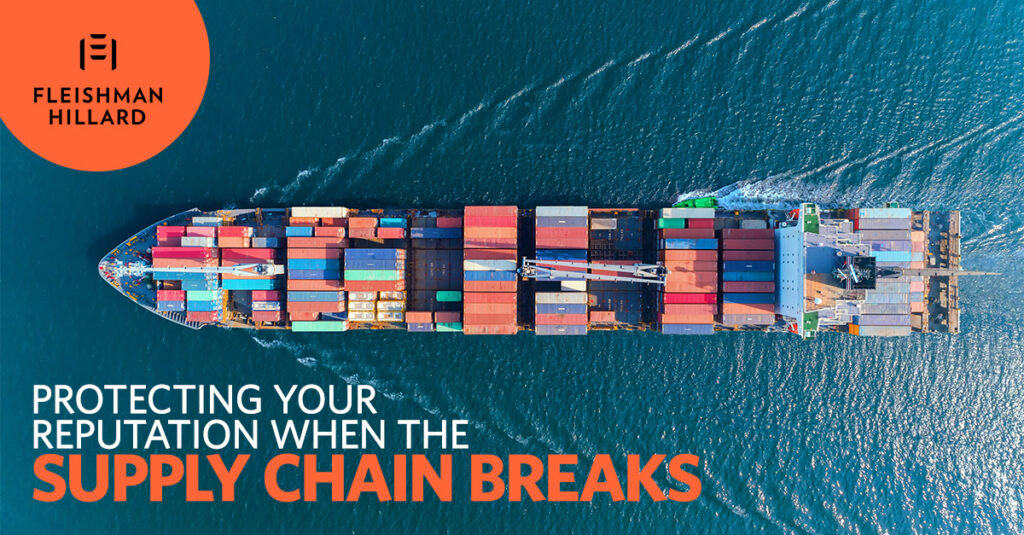Protecting Your Reputation When the Supply Chain Breaks
Media headlines and social posts warning of supply chain strain is a familiar refrain for many manufacturers, especially as hopes that supply chains could normalize as the world moved past the COVID-19 pandemic have yet to bear fruit. The war in Ukraine, the conflict in Gaza, attacks in the Red Sea, the expanding threats on increasing tariffs with China, labor disputes, early season Category 4 hurricanes and more are creating the latest cycle of concern about potential delays, back-ups and increasing prices throughout the global supply chain.
Having learned many lessons since 2020, manufacturers are on standby with their supply chain playbooks, ready to adjust or shift production, inventory and shipping models to meet demand. This year, however, things could be a little more intense.
While supply chain management used to be a subject that only interested trade publications, today it can be found across all top-tier business and financial media. We anticipate media interest will only increase this year thanks to the contested issues in this year’s election — inflation, tariffs, threats to our labor market, reindustrializing the United States — all leading reporters to ask manufacturers how they are being impacted.
For communications professionals, their company’s ability to manage the supply chain dance can have a direct impact on the organization’s reputation. Everyone from your direct customers, to government officials scrutinizing supply chain vulnerabilities with unprecedented rigor, to investors looking for financial impact, to end-use consumers sensitive to price increases are holding manufacturers accountable.
As manufacturers work to balance production and demand, communications professionals are critical strategic partners in case of a potential disruption.
Four questions PR pros can ask their leadership to prepare an integrated communications strategy:
1. What’s the impact timeline and when will customers feel it?
What are the early warning signs at your company and, when they are triggered, is comms in the loop? Timeliness is key to protecting your reputation. Understanding how to get in front of the issue, and thinking ahead to major impact points (holiday sales, financial reporting), helps make sure you have the right strategy from the start.
2. What is potentially the most visible example of the disruption?
Consider what photo might be used by the media. A picture isn’t only worth a thousand words, it’s memorable and shareable. Think empty store shelves, cargo ships backlogged at a port, an auto plant shut down because of missing parts. The wrong image with your company logo on it will speak volumes. What content can you prepare to help media travel with a better representation of the situation – an infographic, a video interview, images of the employees who are part of your workaround solutions?
3. What extraordinary efforts are we making to meet our customers’ needs?
What lessons did the company learn in 2020 and how did it impact their supply chain management? Do you have backup suppliers for critical components, or have you increased inventory? Have you changed pricing models? Is there increased communication with customers? Alternate and creative production hacks (e.g. building trucks without semiconductor chips). Do you have examples of some extraordinary achievements by the company, a local operation or an employee that can tell the story of your commitment to customers?
4. Where are we excelling at customer service and where are we falling behind?
Time for some transparency. Leaks of internal documents and complaint responses are the type of content that jumps from a news story into a viral social media wave. Get the good, bad and ugly from your leaders. A threat to your reputation demands you create authentic messaging that fairly addresses the problem and the hurdles to solving it, and get the organization aligned on using it consistently across all touchpoints – whether public facing or not.
Being prepared for a supply chain disruption doesn’t assume you’ll need to be the first one quoted in a New York Times article, but you’ll want to have the option. If you are managing the crisis better than your competitors, it could be a good move. If you’re trailing the pack, perhaps having a trade association take the lead is a better option. Determining the correct media strategy depends entirely on having a grasp of all the pros and cons of speaking up.
When it comes to responding to a supply chain crisis, there are a large number of factors out of your control… communications shouldn’t be one of them.
Donna Fontana is the Manufacturing and Industrials practice lead at FleishmanHillard

